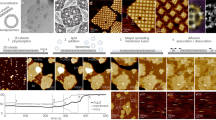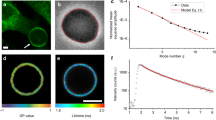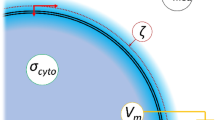Abstract
VARIOUS bimolecular models of the cell membrane have already been made1–3. Such bimolecular films separating two aqueous solutions are formed by applying a solution of phospholipids to the hole in a ‘Teflon’ cup.
This is a preview of subscription content, access via your institution
Access options
Subscribe to this journal
Receive 51 print issues and online access
$199.00 per year
only $3.90 per issue
Buy this article
- Purchase on Springer Link
- Instant access to full article PDF
Prices may be subject to local taxes which are calculated during checkout
Similar content being viewed by others
References
Mueller, P., Rudin, D. O., Thien, H. T., and Wescott, W. C., Nature, 194, 979 (1962).
Huang, C., and Thompson, T. E., J. Mol. Biol., 13, 183 (1965).
Hanai, T., Haydon, P. A., and Taylor, J., Proc. Roy. Soc., A, 281, 377 (1964).
Liberman, E. A., Biophysica (U.S.S.R.), 10, 354 (1965).
Author information
Authors and Affiliations
Rights and permissions
About this article
Cite this article
BABAKOV, A., ERMISHKIN, L. & LIBERMAN, E. Influence of Electric Field on the Capacity of Phospholipid Membranes. Nature 210, 953–955 (1966). https://doi.org/10.1038/210953b0
Issue Date:
DOI: https://doi.org/10.1038/210953b0
This article is cited by
-
Study on self-assembled monolayer of functionalized thiol on gold electrode forming capacitive sensor for chromium(VI) determination
Journal of Solid State Electrochemistry (2019)
-
Activation of bacterial channel MscL in mechanically stimulated droplet interface bilayers
Scientific Reports (2015)
-
Mechanisms of transfer of bioactive molecules through the cell membrane by electroporation
European Biophysics Journal (2015)
-
Capacitance and conductance as tools for the measurement of asymmetric surface potentials and energy barriers of lipid bilayer membranes
The Journal of Membrane Biology (1979)
-
Voltage-induced reflectivity relaxation of bilayer lipid membranes: On changes of bilayer thickness
The Journal of Membrane Biology (1978)
Comments
By submitting a comment you agree to abide by our Terms and Community Guidelines. If you find something abusive or that does not comply with our terms or guidelines please flag it as inappropriate.



